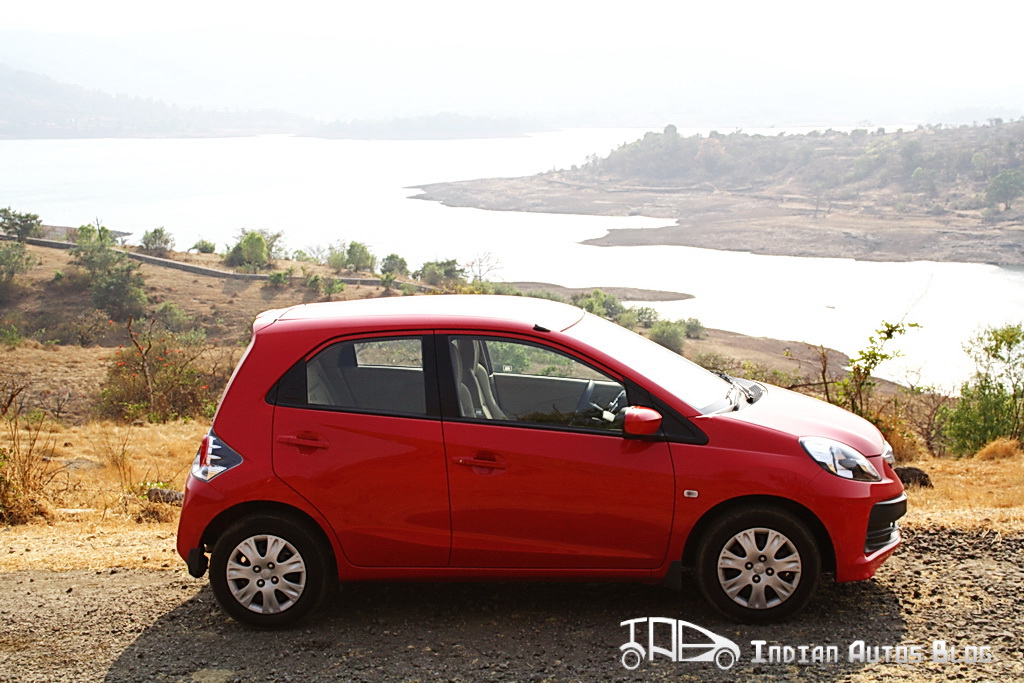Day 3: Honda Brio Driving Impressions
 Yes, the Honda badge does stand for impeccable reliability but it also stands for performance in India. The old Honda City set the benchmark for performance sedans in India which the Civic and Accord cheerfully carried on.
Yes, the Honda badge does stand for impeccable reliability but it also stands for performance in India. The old Honda City set the benchmark for performance sedans in India which the Civic and Accord cheerfully carried on.
Thus the Brio has a daunting task of keeping up with the family. At the same time, the competition is fierce. The Swift, i10 and the A Star offer very good drivability.
So does the Brio have what it takes to be a sporty hatchback? Let’s find out:
What powers the Honda Brio?
The Brio inherits the 1.2L engine from its elder cousin Jazz. However, Honda has reduced the power and torque figures to make sure that it does not compete with Jazz. In the Brio, the 1.2L Petrol i-VTEC produces 87 BHP (@ 6000 rpm) and 109 Nm of torque (@ 4,600 rpm). This healthy dose of power combined with just 930 kg of weight means the Brio’s acceleration is quick. In fact, it is the only car in its segment to cross 100 kph within 13 seconds
Crank the engine and its quickly settles in the idle state. The 5 speed manual is very smooth with precise gear gates and a short throw to give you a sporty drive. The light clutch and a generous low end torque are a boon for city traffic. But that’s not the USP. The USP of the Brio is its high revving i-Vtec which just loves to be throttled.
The Brio loves to be in the high rev band all the time. The peppy engine coupled with a wide base means you are bound to have a lot of fun behind the steering.
Despite the light weight, the Brio’s high speed stability is definitely admirable
How does the Brio handle?
The Brio’s steering is an electronic unit which awesomely light to operate at low speeds. At high speeds, it weighs in fantastically to give you adequate feedback. Changing lanes while tackling traffic is such an easy job in the Brio. It is indeed an extremely easy car to drive.
The Brio’s suspension set up is a bit on the softer side which makes for a bouncy ride. Slight undulations on the road do unsettle the Brio and driving it on concrete roads is very choppy. The 175/65 R14 MRF tyres do a fairly decent job of gripping the tarmac. But when pushed to its limits, there is a good amount of tyre squeals thanks to the generous amount power the engine is putting on the infrastructure. We recommend wider profile tyres to get maximum out of your Brio. The brakes are crisps and fantastic.
One really interesting test we did was to check the ground clearance. Honda cars are notoriously famous for underbody contact on the Indian roads. We put the Brio through some really bad roads and we are glad to tell you that the 165 mm of ground clearance of the body did not touch the ground at all.
What about Fuel economy?
The best fuel economy that we got was 14.03 kmpl. The Brio has an ‘ECO’ meter which is very addictive to drive. Essentially, it analyzes a lot of factors such as throttle position, engine revs, gear selected to calculate the fuel economy. If you are getting maximum miles per drop of fuel, then it lights green. It’s a hugely helpful display for amateur drivers to get the best mileage out of their Brio.
What about safety?
The Brio comes equipped with acceptable amount of safety equipments:
- i-SRS Airbags which Honda claims is better than conventional ones.
- ABS with EBD
Things that I did not like about the drive:
- The choppy ride works against the Brio. It should have been more compliant like the other Hondas
- There is a fair bit of wind noise at high speeds.
- Sharp turns unsettle the Brio which is fun if you are a driving enthusiast but not so much for a lay man.
- Lack of diesel means it caters to a increasingly niche market
The Brio is a super-fun car to drive and probably the easiest to drive in its segment. The awesome visibility coupled with sharp reflexes make it a perfect city car. The size works against the Brio because people may think it’s a cramped car. But when you get on the inside, things are pretty clear. If Honda can ramp up the production and sales outlets, the i10 and Wagon R have a worthy competitor.








